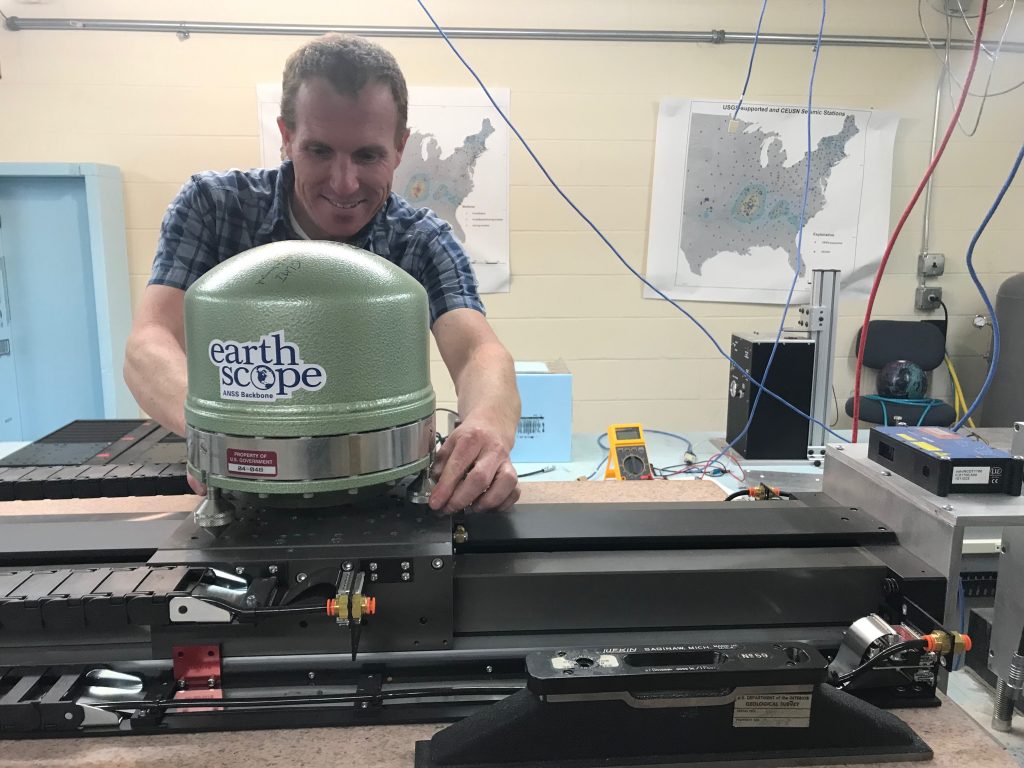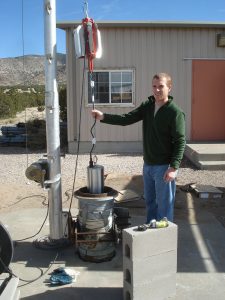15 August 2019–Seismic networks depend on good instrumentation. But testing sensitive seismic instruments to make sure they’re working right can be a challenge, as Adam Ringler, a physical scientist with the U.S. Geological Survey, knows well.
“Seismometers aren’t only sensitive to ground motion, which you want, they’re also sensitive to things you don’t want, like temperature, pressure, wind and magnetic fields,” says Ringler. “You need to be at a location where you can attempt to mitigate these non-seismic sources.”
For Ringler and his colleagues, that location is the Albuquerque Seismological Laboratory (ASL), which sits at the base of the Manzano mountains, approximately fifteen miles southeast of downtown Albuquerque.

“It’s definitely not an exotic field site,” he jokes, “but it does provide a great place to simulate field conditions or try installation methods that might be applicable to Global Seismographic Network stations, which are in very remote places.”
That’s because in terms of seismic noise, the lab is one of the quietest places in the country and one of few locations worldwide where researchers can accurately test seismic instrumentation. Much of the testing is done in the ASL’s above- and below-ground vaults as well as boreholes below the Earth’s surface.
“We test for the self-noise and sensitivity of the instruments and anything else that might limit their performance in a deployment,” Ringler says.
“Sometimes you can record things like barometric pressure at the site and try to correct that data. Other times you want to try to shield the instrument from these undesired signals.”
Shielding instruments from these unwanted non-seismic noise sources is what first brought Ringler’s attention to his current research.
After completing a Ph.D. in mathematics at the University of New Mexico, he was weary of doing a postdoc. “While I liked math,” he says, “I was starting to realize I wanted to be involved in a field that was a bit more tangible.”
Seismology – one of his interests as an undergraduate – immediately stood out because it let him apply his mathematics and computer science background to studying the Earth. He was hired as a student intern at the ASL in 2008 and began working on a thermal shielding project with his mentor, Bob Hutt. It was a project that led to a lot more questions and piqued Ringler’s curiosity.
“Things just sort of clicked,” he says. “I’ve been pursuing such problems ever since.”
Testing seismic instruments allows Ringler to identify limitations in the networks operated by the lab, such as the Global Seismographic Network (GSN), the N4 network and other regional networks.
A recent issue arose when an older vault-style sensor that had been used extensively in the GSN was producing high noise levels. Working with Hutt, Ringler developed specifications for a replacement that could be installed in a borehole and avoid surface noise issues.
“We thought if they would be able to meet these specifications, then we would have a sensor that is comparable to the very best seismometers in the world,” says Ringler.
The result of their work led to the development of a new seismometer that helped reduce noise levels across the GSN, making for clearer recordings. But with the new instrument came a need for a new method of installation.
“A large portion of GSN stations are stations with vaults,” Ringler explains. “We had to develop a method to drill through the vault’s seismic piers and install the sensors in a posthole fashion.”
The change ultimately helped reduce noise levels across the GSN, making for clearer recordings.

When he’s not testing instruments themselves, Ringler spends the bulk of his workday at a computer studying the data they produce. He’s particularly interested in how well the ASL’s networks record long-period surface waves – seismic waves with periods of a minute or more. These typically come from teleseismic earthquakes, which are recorded hundreds or even thousands of miles from where they occur.
He’s also interested in normal modes – waves that constantly vibrate throughout the planet. One example is the low frequency rate at which the Earth naturally expands and contracts, referred to as the 0S0 “breathing mode.” Recording permanently excited long-period modes, known as Earth hum, is another interest.
Long-period surface waves and normal modes have proven useful for better understanding the mechanisms behind large earthquakes, says Ringler. “They can give us information about the mantle and core that body waves [seismic waves that pass through the interior of the Earth] aren’t sensitive to.”
But the size and time frame of these signals pose complications, even for the most finely tuned seismic instruments. “Normal modes are fairly difficult to record because they are very long-period and noise tends to dominate your records,” says Ringler.
Improving data is one of his main goals moving forward. As he and his colleagues test and install new sensors and systems, scientists use these data in new and different ways.
“We often try to work with other researchers to see if we can modify their methodology to find ways to improve our data,” Ringler says. “This helps us to refine our processes of testing and deploying to better enable them to do their science.”
Looking forward, Ringler wants to keep working on ways to make seismic networks better.
“I’d really like to see how far we can take improvements in the GSN,” he says. “There are still a number of things we have not seismically observed, that theory has suggested should be observable, and it would be awesome to contribute in a way to see these observations.”
But it’s never an easy process. “While we know more than we did ten years ago, we also have more questions now,” he says.
